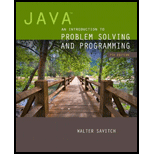
Concept explainers
Explanation of Solution
a.
Program:
//Import necessary header files
import java.util.*;
//Define the class
class Main
{
//Define the main() method
public static void main(String[] args)
{
//Initialize the variable x as 4
int x = 4;
//Check the condition
if (x > 5)
//True, Print A
System.out.println("A");
//Check the condition
else if (x < 10)
//True, Print B
System...
Explanation of Solution
b.
Program:
//Import necessary header files
import java.util.*;
//Define the class
class Main
{
//Define the main() method
public static void main(String[] args)
{
//Initialize the variable x as 5
int x = 5;
//Check the condition
if (x > 5)
//True, Print A
System.out.println("A");
//Check the condition
else if (x < 10)
//True, Print B
System...
Explanation of Solution
c.
Program:
//Import necessary header files
import java.util.*;
//Define the class
class Main
{
//Define the main() method
public static void main(String[] args)
{
//Initialize the variable x as 6
int x = 6;
//Check the condition
if (x > 5)
//True, Print A
System.out.println("A");
//Check the condition
else if (x < 10)
//True, Print B
System...
Explanation of Solution
d.
Program:
//Import necessary header files
import java.util.*;
//Define the class
class Main
{
//Define the main() method
public static void main(String[] args)
{
//Initialize the variable x as 9
int x = 9;
//Check the condition
if (x > 5)
//True, Print A
System.out.println("A");
//Check the condition
else if (x < 10)
//True, Print B
System...
Explanation of Solution
e.
Program:
//Import necessary header files
import java.util.*;
//Define the class
class Main
{
//Define the main() method
public static void main(String[] args)
{
//Initialize the variable x as 10
int x = 10;
//Check the condition
if (x > 5)
//True, Print A
System.out.println("A");
//Check the condition
else if (x < 10)
//True, Print B
System...
Explanation of Solution
f.
Program:
//Import necessary header files
import java.util.*;
//Define the class
class Main
{
//Define the main() method
public static void main(String[] args)
{
//Initialize the variable x as 11
int x = 11;
//Check the condition
if (x > 5)
//True, Print A
System.out.println("A");
//Check the condition
else if (x < 10)
//True, Print B
System...
Want to see the full answer?
Check out a sample textbook solution
Chapter 3 Solutions
Java: An Introduction to Problem Solving and Programming (7th Edition)
- Provide a detailed explanation of the architecture on the diagramarrow_forwardhello please explain the architecture in the diagram below. thanks youarrow_forwardComplete the JavaScript function addPixels () to calculate the sum of pixelAmount and the given element's cssProperty value, and return the new "px" value. Ex: If helloElem's width is 150px, then calling addPixels (hello Elem, "width", 50) should return 150px + 50px = "200px". SHOW EXPECTED HTML JavaScript 1 function addPixels (element, cssProperty, pixelAmount) { 2 3 /* Your solution goes here *1 4 } 5 6 const helloElem = document.querySelector("# helloMessage"); 7 const newVal = addPixels (helloElem, "width", 50); 8 helloElem.style.setProperty("width", newVal); [arrow_forward
- Solve in MATLABarrow_forwardHello please look at the attached picture. I need an detailed explanation of the architecturearrow_forwardInformation Security Risk and Vulnerability Assessment 1- Which TCP/IP protocol is used to convert the IP address to the Mac address? Explain 2-What popular switch feature allows you to create communication boundaries between systems connected to the switch3- what types of vulnerability directly related to the programmer of the software?4- Who ensures the entity implements appropriate security controls to protect an asset? Please do not use AI and add refrencearrow_forward
- Could you help me to know features of the following concepts: - commercial CA - memory integrity - WMI filterarrow_forwardBriefly describe the issues involved in using ATM technology in Local Area Networksarrow_forwardFor this question you will perform two levels of quicksort on an array containing these numbers: 59 41 61 73 43 57 50 13 96 88 42 77 27 95 32 89 In the first blank, enter the array contents after the top level partition. In the second blank, enter the array contents after one more partition of the left-hand subarray resulting from the first partition. In the third blank, enter the array contents after one more partition of the right-hand subarray resulting from the first partition. Print the numbers with a single space between them. Use the algorithm we covered in class, in which the first element of the subarray is the partition value. Question 1 options: Blank # 1 Blank # 2 Blank # 3arrow_forward
 C++ Programming: From Problem Analysis to Program...Computer ScienceISBN:9781337102087Author:D. S. MalikPublisher:Cengage Learning
C++ Programming: From Problem Analysis to Program...Computer ScienceISBN:9781337102087Author:D. S. MalikPublisher:Cengage Learning Programming with Microsoft Visual Basic 2017Computer ScienceISBN:9781337102124Author:Diane ZakPublisher:Cengage Learning
Programming with Microsoft Visual Basic 2017Computer ScienceISBN:9781337102124Author:Diane ZakPublisher:Cengage Learning Microsoft Visual C#Computer ScienceISBN:9781337102100Author:Joyce, Farrell.Publisher:Cengage Learning,
Microsoft Visual C#Computer ScienceISBN:9781337102100Author:Joyce, Farrell.Publisher:Cengage Learning, C++ for Engineers and ScientistsComputer ScienceISBN:9781133187844Author:Bronson, Gary J.Publisher:Course Technology Ptr
C++ for Engineers and ScientistsComputer ScienceISBN:9781133187844Author:Bronson, Gary J.Publisher:Course Technology Ptr EBK JAVA PROGRAMMINGComputer ScienceISBN:9781337671385Author:FARRELLPublisher:CENGAGE LEARNING - CONSIGNMENT
EBK JAVA PROGRAMMINGComputer ScienceISBN:9781337671385Author:FARRELLPublisher:CENGAGE LEARNING - CONSIGNMENT EBK JAVA PROGRAMMINGComputer ScienceISBN:9781305480537Author:FARRELLPublisher:CENGAGE LEARNING - CONSIGNMENT
EBK JAVA PROGRAMMINGComputer ScienceISBN:9781305480537Author:FARRELLPublisher:CENGAGE LEARNING - CONSIGNMENT





